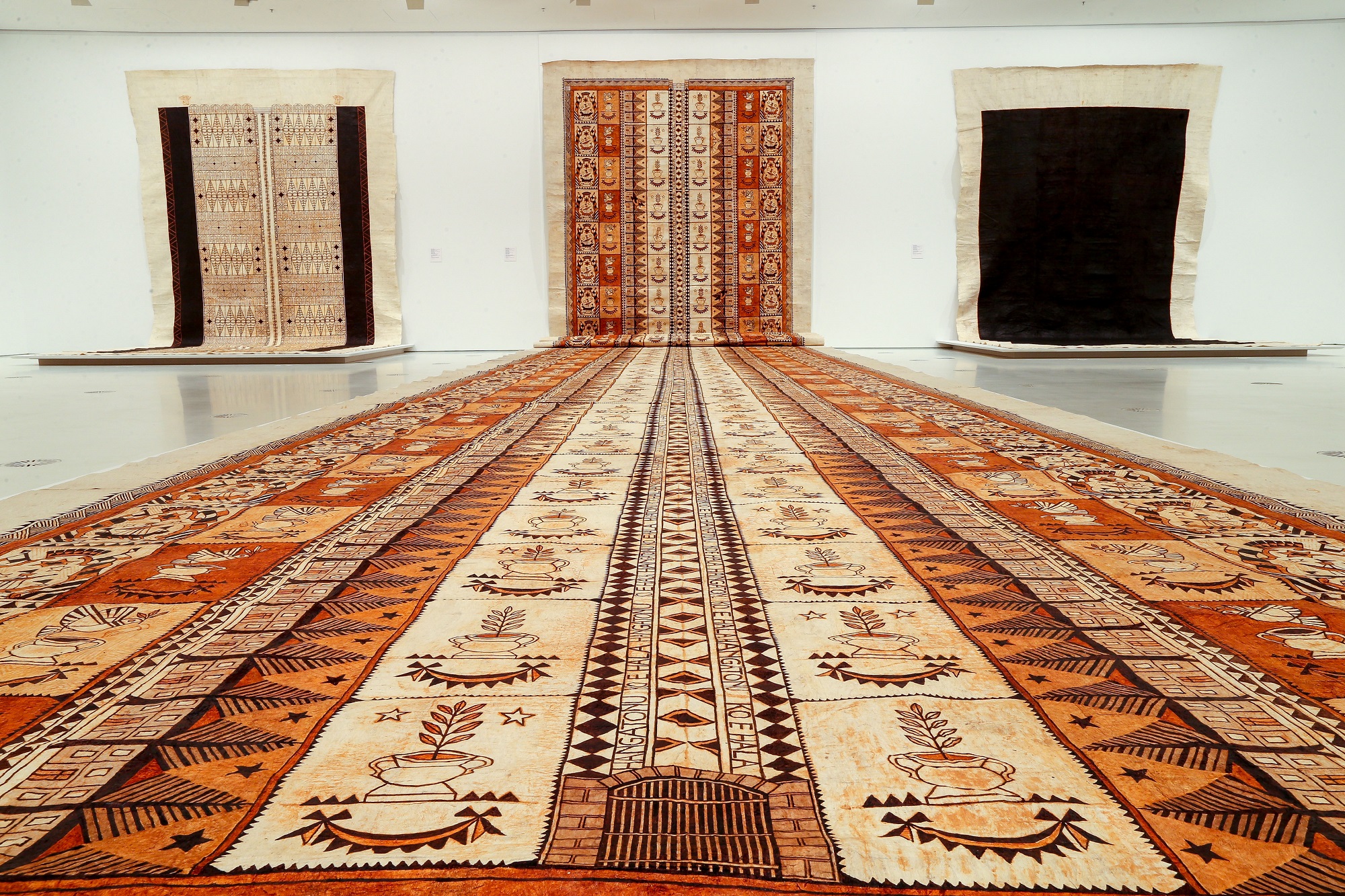ロビン・ホワイト
Robin White

大通り沿いで目にしたもの(「コ・エ・ハラ・ハンガトゥヌ:まっすぐな道」シリーズより)
2015-2016年
顔料、植物染料、樹皮布
2,400×380 cm
作家蔵
Seen Along the Avenue (from the series “Ko e Hala Hangatonu: The Straight Path”)
2015-2016
Earth pigment and natural dye on ngatu (barkcloth
2,400 x 380 cm
Collection of the artist
Courtesy: McLeavy Gallery, Wellington
ロビン・ホワイト&ルハ・フィフィタ
大通り沿いで目にしたもの(「コ・エ・ハラ・ハンガトゥヌ:まっすぐな道」シリーズより)
2015-2016年
顔料、植物染料、樹皮布
2,400×380 cm
作家蔵
本作は「ンガトュ」というトンガの伝統的なタパ(樹皮布)で作られています。和紙のような質感をしており、カジノキの木の内側の樹皮を叩いて柔らかくして広げ、薄い紙状にしたものです。
タイトルの「大通り」はイスラエルのハイファにある、地中海沿岸からカルメル山麓まで続く「ベン=グリオン通り」を指します。中心に描かれた白い二重線は、トンガ王国トンガタプ島の王宮から王家の墓まで続く「
タパは、オセアニアで人々が人生の節目に身にまとうもので、その制作には大変な手間と人手を要します。本作もトンガのハヴェルロトに住む女性たちと共同制作されました。ホワイトと共同制作者のルハ・フィフィタは、この共同制作が何千年にもわたる太平洋でのタパ作りへのオマージュになるとともに、コミュニティに一体感を生み出し、人種や年齢に関係なく人々を結びつけるものとなることを願っています。
Robin White and Ruha Fifita
Seen Along the Avenue (from the series “Ko e Hala Hangatonu: The Straight Path”)
2015-2016
Earth pigment and natural dye on ngatu (barkcloth)
2,400 x 380 cm
Collection of the artist
Courtesy: McLeavy Gallery, Wellington
This work was made from a type of traditional Tongan tapa (bark) cloth called ngatu, which has a texture similar to Japanese washi paper. It is made by beating the inner bark of the paper mulberry tree to soften it, before spreading it out to make a thin paper-like material.
The “avenue” in the title refers to Ben Gurion Street in Haifa, Israel, which stretches from the Mediterranean coast to the foot of Mount Carmel. The double white line in the center of the painting is inspired by the pathway of pines called Hala Paini that leads from the royal palace to the royal tombs on the island of Tongatapu in the Kingdom of Tonga. While the dove bearing an olive branch and the black vehicle of the Tongan king are symbols of victory and life, the fighter plane represents the constant threat of war, crisis, and death. The simplified motifs depict the repeated history of mankind.
Tapa cloth is worn by people in Oceania to mark certain milestones in their lives, and its production requires a great deal of time and manpower. This work, too, was made in collaboration with women living in Haveluloto, Tonga. In addition to paying homage to thousands of years of tapa making in the Pacific, White and her co-creator Ruha Fifita hope that this collaborative effort will serve to foster a sense of unity in the community and bring people together regardless of race or age.

夏草
2001年
油彩、壁紙
156×624 cm
所蔵:アラトイ・ワイララパ美術館・歴史博物館(マスタートン)
Summer Grass
2001
Oil on wallpaper
156 x 624 cm
Collection: Aratoi Wairarapa Museum of Art and History, Masterton
ロビン・ホワイト&飯村惠以子
夏草
2001年
油彩、壁紙
156×624 cm
所蔵:アラトイ・ワイララパ美術館・歴史博物館(マスタートン)
本作は、第二次世界大戦中の1943年に、ニュージーランド北島南部ワイララパ地方のフェザーストン日本人捕虜収容所で起きたフェザーストン事件の犠牲者に哀悼の意を捧げる作品です。1999年にホワイトがこの地方に移住し、この事件について知ったことがきっかけで制作されました。タイトルの「夏草」は、その慰霊碑に刻まれている松尾芭蕉(1644-1694年)の俳句「夏草や
作品には、日本人捕虜として1942年にフェザーストン収容所に送られ、戦後牧師となった
Robin White and Iimura Keiko
Summer Grass
2001
Oil on wallpaper
156 x 624 cm
Collection: Aratoi Wairarapa Museum of Art and History, Masterton
This work is a tribute to the victims of the Featherston Incident, which occurred at the Featherston prisoner of war camp in the Wairarapa region in the southern part of North Island, New Zealand in 1943, during World War II. White relocated to this area in 1999, and was inspired to create this work after learning about this incident. The title, Summer Grass, is a reference to the haiku by Matsuo Basho (1644-1694), “Natsukusa ya/tsuwamono domo ga/yume no ato,” which is inscribed on the cenotaph dedicated to this incident.
Texts written on the work are based on a biblical quote from the book From the Sea of Death to the Pulpit by Shinya Michiharu (1920-2016), a Japanese prisoner of war who was sent to the camp at Featherston in 1942 and became a pastor after the war. The content is familiar to New Zealanders, who are more familiar with the teachings of Christianity, but they cannot read it because it is written in Japanese kanji characters. On the other hand, the New Zealand landscape is unfamiliar to Japanese people. This work is a sorrowful demonstration of the conflict and division between two different cultures that led to the horrific incident.
アーティスト一覧ARTISTS
- Etel Adnan|エテル・アドナン
- Phyllida Barlow|フィリダ・バーロウ
- Anna Boghiguian|アンナ・ボギギアン
- Miriam Cahn|ミリアム・カーン
- Lili Dujourie|リリ・デュジュリー
- Anna Bella Geiger|アンナ・ベラ・ガイゲル
- Beatriz González|ベアトリス・ゴンザレス
- Carmen Herrera|カルメン・ヘレラ
- Kim Soun-Gui|キム・スンギ
- Suzanne Lacy|スザンヌ・レイシー
- Mishima Kimiyo|三島喜美代
- Miyamoto Kazuko|宮本和子
- Senga Nengudi|センガ・ネングディ
- Nunung WS|ヌヌンWS
- Arpita Singh|アルピタ・シン
- Robin White|ロビン・ホワイト

